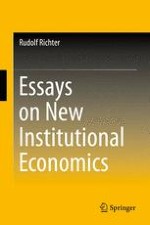2015 | OriginalPaper | Chapter
10. Methodology from the Viewpoint of an Economic Theorist: Fifty Years On
Author : Rudolf Richter
Published in: Essays on New Institutional Economics
Publisher: Springer International Publishing
Activate our intelligent search to find suitable subject content or patents.
Select sections of text to find matching patents with Artificial Intelligence. powered by
Select sections of text to find additional relevant content using AI-assisted search. powered by
